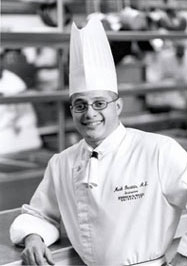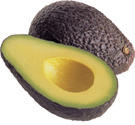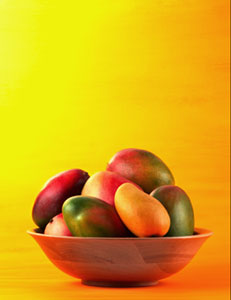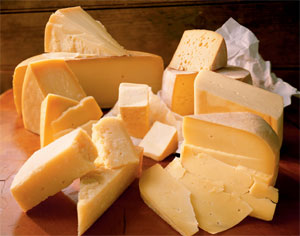Award-Winning Lesson Plan on Center-of-the-Plate
Monday, 01 September 2008 10:09Preparing a rack-of-lamb dinner for two, from ACF’s 2008 Educator of the Year
By Wilfred Beriau, CEC, CCE, AAC
 Center-of-the-plate proteins, including American lamb, are the focus of this lesson plan for freshman in the Associate of Applied Science degree program at Southern Maine Community College in South Portland. The course, of which this lesson is a part, addresses the basic fabrication of meat, fish and poultry; stocks; the five major sauces; derivative sauces; coulis, jus lié, and reductions. The class covers moist and dry methods of cooking that demonstrate appropriate cooking methods for a wide array of products.
Center-of-the-plate proteins, including American lamb, are the focus of this lesson plan for freshman in the Associate of Applied Science degree program at Southern Maine Community College in South Portland. The course, of which this lesson is a part, addresses the basic fabrication of meat, fish and poultry; stocks; the five major sauces; derivative sauces; coulis, jus lié, and reductions. The class covers moist and dry methods of cooking that demonstrate appropriate cooking methods for a wide array of products.
A key component of this lesson plan involves the preparation and presentation of a NAMP/#204A domestic rack of lamb with accompaniments of a starch, a vegetable, jus lié and herb garnish.

 As the demographic of culinary schools shifts to a much more multicultural environment, embracing and celebrating cultural diversity is becoming part of the everyday life of culinary institutions. The challenge for culinary instructors is in finding a way to integrate cultural diversity into the curriculum in a tacit manner, one in which students might not recognize the true objectives, yet at the same time, achieve a sense of accomplishment and pride in their own cultural heritage and cuisine.
As the demographic of culinary schools shifts to a much more multicultural environment, embracing and celebrating cultural diversity is becoming part of the everyday life of culinary institutions. The challenge for culinary instructors is in finding a way to integrate cultural diversity into the curriculum in a tacit manner, one in which students might not recognize the true objectives, yet at the same time, achieve a sense of accomplishment and pride in their own cultural heritage and cuisine. Shirley P. Rauh, FACS chair at Lutheran High School South in St. Louis, submitted the following Lesson Plan as a “teaching tip” entry in the 2007 CAFÉ Scholarship program that awarded four winners grants toward registration at a CAFÉ workshop or the Leadership Conference this summer.
Shirley P. Rauh, FACS chair at Lutheran High School South in St. Louis, submitted the following Lesson Plan as a “teaching tip” entry in the 2007 CAFÉ Scholarship program that awarded four winners grants toward registration at a CAFÉ workshop or the Leadership Conference this summer.  This comprehensive lesson plan provides a basic understanding of American lamb, with a particular focus on the leg, from farm to plate. Topics include product acquisition, leg cuts and fabrication, safe handling and sanitation, best applied cooking techniques and methods, nutrition, and ideal flavors to marry with American lamb, as well as discussion questions.
This comprehensive lesson plan provides a basic understanding of American lamb, with a particular focus on the leg, from farm to plate. Topics include product acquisition, leg cuts and fabrication, safe handling and sanitation, best applied cooking techniques and methods, nutrition, and ideal flavors to marry with American lamb, as well as discussion questions.  Presented by Avocados from Mexico
Presented by Avocados from Mexico Contrary to popular belief, the mango is available any time of year, and the Orlando, Fla.-based National Mango Board (NMB) has made it its mission to educate U.S. consumers on selection and preparation of the world’s most consumed fruit. Since 1995, mango consumption has increased by 100% in the United States (U.S. Outlook Report 2004). Approximately only 30% of U.S. households consume mangos today, however.
Contrary to popular belief, the mango is available any time of year, and the Orlando, Fla.-based National Mango Board (NMB) has made it its mission to educate U.S. consumers on selection and preparation of the world’s most consumed fruit. Since 1995, mango consumption has increased by 100% in the United States (U.S. Outlook Report 2004). Approximately only 30% of U.S. households consume mangos today, however. Since 2001, cheese was the No. 1 ingredient added to the menus of the top 200 restaurant chains in the appetizers, entrees, salads and sandwiches categories. Attached as a PowerPoint presentation is a complete lesson plan on teaching the menu power of cheese, particularly those cheeses made in Wisconsin, from the standpoints of flavor, identification, grading, menu trends and marketing. The lesson plan is easily customizable with the removal or addition of slides to fit your needs.
Since 2001, cheese was the No. 1 ingredient added to the menus of the top 200 restaurant chains in the appetizers, entrees, salads and sandwiches categories. Attached as a PowerPoint presentation is a complete lesson plan on teaching the menu power of cheese, particularly those cheeses made in Wisconsin, from the standpoints of flavor, identification, grading, menu trends and marketing. The lesson plan is easily customizable with the removal or addition of slides to fit your needs.